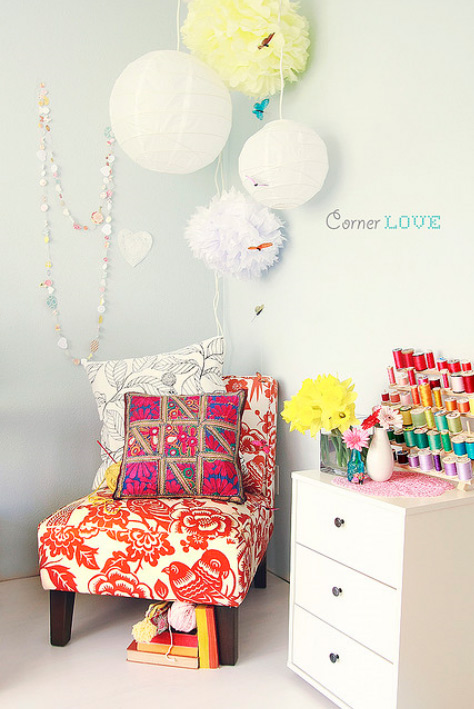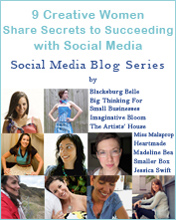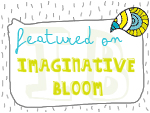 Corner Love by Debee Campos on Flickr
Corner Love by Debee Campos on Flickr
Do you wonder what you should blog about? Do you want to know how to get your readers interested in your art and how to pull in your target market?
I constantly get asked about this stuff. And, here are the 5 blog topics that I always recommend:
1. How you became an artist.
Your blog readers want to know more about you, especially if they read your blog regularly. Knowing why and how you became an artist helps your readers feel more connected to you which also means they’re going to be more likely to buy from you.
So, what’s the story? Did you always know that you were meant to be an artist? Did people support you when you told them you wanted to be an artist or did they encourage you to get a “real” job? Did you transition from a paralegal to an artist after many years of making your art part-time?
It doesn’t matter what the story is—it just matters that you tell it. Once you’ve written it, consider including it on your “About” page, so it doesn’t get buried in your archives.
2. Your specialty and why you choose it.
If you’re a mixed media artist, how did that end up happening? When did you first learn about mixed media art and why did you fall in love with it? If you’re a sculptor, what led you down that path?
Talk about the different types of art that you’ve attempted and why you chose watercolor painting, fiber art, or photography. Tell the journey you took to find the type of art that makes your heart sing.
3. The story behind a piece of art.
This is something you should do over and over.
Often, artists ask me how to write product descriptions that will appeal to their target markets. One of the main tips I tell them is to include a small piece of the story behind the piece of art in the product description. Now, you don’t want to include five paragraphs on why you painted a bridge in the product description. You’d just want to include the gist of it. But, you could include the 5 paragraph story in a blog post.
If you do this, you should link to where your readers can purchase the piece of art. You should also link to the story in the product description in case potential customers are interested in reading more.
4. Your inspiration.
Readers and potential customers want to know where you draw inspiration. This is another post that will make your readers feel more connected to you and your work. You could break this down into a series of posts: People that Inspire My Art, Places that Inspire My Art, Things that Inspire My Art, and Colors that Inspire My Art.
Include pictures of art and links to where it can be purchased with each post.
5. Your creative process.
People who appreciate art are often fascinated by the artist’s creative process. Show pictures of your art in stages and explain your process or show a fast moving video of you making a piece of art. This helps your readers feel more connected, but it also shows them the intensity and time that goes into the art that you create.
________________________________________________________
 About April
About April
April Bowles-Olin helps creative entrepreneurs turn their dreams into reality through her website, Blacksburg Belle, where she writes about marketing, blogging, and increasing business success. She uses her background in psychology to help creatives reach their goals, take charge of their inner critic, and build businesses around their dream lifestyles. April fell in love with art the day her mother handed her a box of brightly colored crayons, and believes that living your truth, creating daily, and loving fully leads to happiness.
 Corner Love by Debee Campos on Flickr
Corner Love by Debee Campos on Flickr
Ti chiedi di cosa dovresti scrivere nel tuo blog? Vuoi sapere come far si che i tuoi lettori siano interessati alla tua arte e come attirare il tuo target di mercato?
Queste cose mi vengono chieste di continuo. Ed ecco qui i 5 argomenti che io raccomando sempre:
1. Come sei diventato un artista.
I lettori del tuo blog vogliono sapere di più su di te, specialmente se leggono il tuo blog regolarmente. Sapere perché e come sei diventato un artista aiuta i tuoi lettori a sentirsi più connessi a te, e questo significa anche che saranno anche più propensi ad acquistare da te.
Quindi, qual è la storia? Hai sempre saputo che saresti diventato un artista? Le persone ti hanno supportato quando hai detto loro che volevi essere un artista o ti incoraggiavano ad avere un lavoro “vero”? Sei passato da un lavoro tradizionale a quello di artista dopo aver fatto per molti anni l’artista part-time?
Non importa quale sia la storia – l’importante è che la racconti. Una volta che l’hai scritta, considera l’idea di inserirla nella tua “About” page (la pagina “chi sono/cosa faccio”), così che non sparisca nei tuoi archivi.
2. La tua specialità e perché l’hai scelta.
Se sei un artista che utilizza materiali differenti, come sei arrivato a questa scelta? Quando è stata la prima volta che hai imparato l’utilizzo di quei materiali mescolati insieme e perché te ne sei innamorato? Se sei uno scultore, cosa ti ha portato su quella strada?
Parla dei differenti tipi di arte a cui ti sei avvicinato e perché hai scelto la pittura ad acquarelli, la lavorazione dei filati, o la fotografia. Racconta del viaggio che hai intrapreso per trovare il tipo di arte che ti fa cantare il cuore.
3. La storia dietro ad una creazione artistica.
Questo è qualcosa che dovresti fare più e più volte.
Spesso, gli artisti mi chiedono come scrivere descrizioni di prodotti rivolti ai loro target di mercato. Una delle principali regole che dico loro è di includere nella descrizione un piccolo pezzo della storia che sta dietro alla realizzazione di quel prodotto artistico. Ora, non devi includere nella descrizione cinque paragrafi del perché hai dipinto un ponte. Dovresti giusto riassumerne il senso. Però puoi includere la storia di 5 paragrafi in un post del blog.
Se lo fai, dovresti linkare alla pagina in cui i tuoi lettori possono acquistare il prodotto. Dovresti anche linkare la storia nella descrizione del prodotto nel caso in cui i potenziali clienti siano interessati a saperne di più.
4. La tua ispirazione.
I lettori e i potenziali clienti vogliono sapere da dove prendi ispirazione. Questo è un’altro post che farà sentire i tuoi lettori più connessi a te e al tuo lavoro. Potresti anche suddividerlo in una serie di posts: Persone che ispirano la mia arte, Posti che ispirano la mia arte, Cose che ispirano la mia arte, e Colori che ispirano la mia arte.
Includi immagini dei tuo prodotti artistici e aggiungi in ogni posts i links a dove possono essere acquistati.
5. Il tuo processo creativo.
Le persone che apprezzano l’arte sono spesso affascinate dal processo creativo dell’artista. Mostra delle foto delle fasi di creazione di un prodotto artistico e spiega il processo o mostra un video velocizzato di te mentre crei. Questo oltre ad aiutare i tuoi lettori a sentirsi più connessi, mostra loro anche l’intensità e il tempo di cui necessiatano le tue creazioni per essere realizzate.
________________________________________________________
 Chi è April
Chi è April
April Bowles-Olin aiuta gli imprenditori creativi a far diventare i loro sogni realtà attraverso il suo sito, Blacksburg Belle, dove scrive di marketing, blogging, e di come aumentare il successo della vostra attività. Usa il suo background in psicologia per aiutare i creativi a raggiungere i loro obiettivi, a prendere atto del loro senso critico, e costruire un’attività plasmata sullo stile di vita che sognano. April si è innamorata dell’arte il giorno in cui sua madre le ha messo in mano una scatola di vivaci matite colorate, e crede che vivere la propria verità creando quotidianamente e amando pienamente, porti alla felicità.





What i don’t realize is if truth be told how you are no longer actually much more neatly-preferred than you
may be right now. You’re so intelligent. You already know thus significantly in terms of
this topic, produced me individually consider it from so many numerous angles.
Its like men and women are not fascinated unless it is something to do
with Girl gaga! Your own stuffs outstanding.
All the time handle it up!
My spouse and I stumbled over here by a different page and thought I
might check things out. I like what I see so now i am following you.
Look forward to checking out your web page again.
I will immediately grab your rss feed as I can’t find your e-mail subscription link or
newsletter service. Do you have any? Kindly permit me recognize so that I may subscribe.
Thanks.
Thank you for posting and sharing your knowledge. This is a great start for my sister and I as we being our illustration website. Thank you!
Kind regards,
WS
Well, I know this post is almost a year old but it’s still relevant. Found it on a Google search after having just recently started up my first art blog and trying to think of ideas for blog posts. Thanks for the tips, will add this to my bookmarks for future reference!
Hi Karin!
Glad you ended up here and that the post it’s useful for your new blog adventure!
You’re welcome and thanks for stopping by!
Good luck for your project :)
Thanks for the awesome artical! I share it on my blog with fellow bloggers who are asking the same question of what to blog about.
http://kittyscreation.blogspot.com/
I’m happy this post is of inspiration for so many of you! Thank you for stopping by!
Thanks for this post. It is certainly a useful list of ideas for those just starting out on their blog and unsure of what to say. I am going to include it in my weekly link round up for my readers on Monday. I hope many of them will come over and become your readers, too. I’m new here, but I can see I’ll be back often. Thanks!
Yes, I’m sure that many creatives will find those tips by April really helpful.
Thanks for your feedback Martha and also for spreading about the post on your weekly round up!
lovely post. ill keep it in mind!!
Thanks! good reading :)
Amazingly helpful. Printed out and will read and re-read. Thanks
Congrats! Irene for the reading list!
Those are great advices!! :)
xo
Guisela
Excellent post. short and informative!!!
Thx.
Intelligence and simplicity – easy to understand how you think.
We need more insights like this in this thread.
thank you!
April,
THanks for a great post and for great ideas. I will definitely use these, maybe as a series. It’s easy to forget that sometimes the primary goal of our readers is to have a relationship with us as writers (especially on a blog). When we facilitate that, we are really rewarding readers for their reading.
Thanks for posting. I’ll be back.
Robin Ingle
This is great April!! thanks for the wonderful advice!!!
Thanks for stopping by guys!
@ Abby: I’m happy to hear you already thought about your own story. I can feel your energy and passion till here and I’m sure this will be reflected by your words. So, good work!
@ Making Strangers: Great! Good work to you too :)
@ Molly: Happy you find it useful Molly! Thanks also for your kind words for the Imaginative Bloom blog!
Thank you so much for this excellent information. I needed a nudge to focus on this. And Irene you have an amazing blog! ~Molly
(got here via Daniellexo tweet)
Thanks for this post, I shall heed your advice :)
very good advice! I’ve been blogging more lately, so I will definitely use these topics.
Plus my “how I became an artist” story is awesome if I do say so myself :)
thanks for the inspiration
Abby
This post has given me the confidence to write more about myself and what goes into my art.
For some reason I was always worried about boring people but when I think about it, I LOVE reading about other peoples inspiration and life stories so why shouldn’t people think the same about me!
Really great post April & thanks to Imaginative Bloom for posting it! x
Hi Helen, thanks for your feedback on this topic.
And yes, I definitely think you shouldn’t worry about this. I love reading this kind of posts too.
I think that it’s just important to understand what is the gist of your story, the most interesting, curious or funny things to share.
Good work!
THIS was JUST what I needed to read…I’m not sure why but I never thought that I should be addding all these details for my readers…but it’s true, because I love reading out other artists and their “work process” or what inspires them!!!
I think this article will have a huge impact on how I blog…and how I aproach showing my work.
THANK YOU!!!!
hugs
Char.x
I’m happy this post has been so useful Char!
I think all artists love reading about the work process of others artists.
As it is for some “behind the scene” images and stories, creative work spaces/labs, etc.
They are a big source of inspiration and motivation for each one of us!
[...] “5 Blog Posts Every Artist Should Write,” Irene Zuccarello, Imaginative Bloom: This list nails it. Enough said. [...]